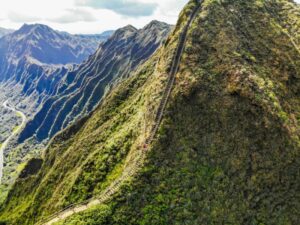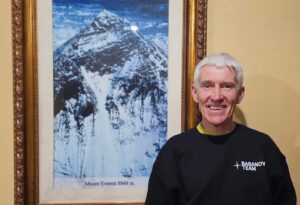Last week, we reported on a new line climbed on Pumori by a small Romanian team. The few details available suggested a remarkable climb, so we contacted the team’s youngest member, Teofil Vlad, for the full story:

Romeo “Romica” Popa, photographed by teofil Vlad on Pumori summit ridge, 400 meters below the top. Photo: T. Vlad
EW: Pumori provides a hard enough climb up its normal route. How did you guys come up with the idea of a new line?
TV: Zsolt Torok and I were discussing it since January. Romeo Popa was also interested. At the time, we hadn’t decided to try something new. At one point, six of us were involved in the project. Some preferred a new line and others the normal route. Eventually, for various reasons, only Zsolt, Popa and I remained to do the project.

Zsolt Torok climbing on Pumori SE face
EW: Did you guys know each other well?
TV: I’ve known Zsolt since 2010 and had heard about him for even longer. He has climbed almost all the classic lines in the Alps. In 2013, we teamed up on Nanga Parbat, with three others, do climb the Schell route up the Rupal Face. That was the time when terrorists shot people on the mountain’s Diamir side, but we were alone on the Rupal Face and we decided to continue. Four of us, including Zsolt, made it to the top. That expedition created a close connection between us. In 2016, we climbed Ama Dablam together in spring, in bad conditions. Only we and one other team succeeded that season. Earlier this year, we went up Freney’s Central Pillar in the Mont Blanc massif and the North Face of Civetta.
As for Romeo, we first met 18 years ago and lately our trails have crossed more and more often. He is a first-class ice climber: It’s his true passion. He’s done a large number of classic icefalls and important peaks in Europe. He tried Ama Dablam with us but he had bad luck and had to go down. We also skied and climbed mixed and rock routes in the Carpathians. All three of us climbed a hard, obscure line two years ago in the Carpathians and we climbed the Matterhorn as a team this summer.

Everest-Lhotse-Nuptse triad, as seen from Pumori.
EW: Zsolt Torok attempted Pumori last year. Did he tried the same line you’ve now completed? If so, what made the difference this time?
TV: Yes, Zsolt tried that line in spring 2017, with Vlad Capusan, but avalanches turned them back, so the line was very clear in his mind. We hoped autumn would give better conditions, and it did. The success rate on Pumori is very low anyway, no matter what the route. So why not try a new one?
EW: Were you totally committed to a new line, or did you consider the normal route?
TV: I gave it a lot of thought before heading to Nepal. For me, it was both a temptation and a source of doubt. I was aware what it means to put up a new route, in terms of both commitment and satisfaction. But Zsolt had so many photos, and we discussed them methodically: what should be done at this point and that point … Eventually, he convinced me. The SE face of Pumori was on!
EW: What was your strategy and style?
TV: We fixed an advanced base camp at the foot of the wall. Above it, we went alpine style. We had good conditions – a lot of ice connecting the wall almost from bottom to top – very aesthetic. The cruxes featured dry rock in the middle of the route and a section of soft snow over rock at a ramp in the last quarter, where it was difficult to place proper protection. We spent four days on the wall. We made the first two bivouacs on ledges with a tarp. The first one, in particular, was horrible, with our feet hanging. We were half-lying, half-sitting. On the next ones, we managed to pitch a one-kilo, two-man bivy tent (although, yes, there were three of us).
Our third bivouac was not exposed to avalanches, but we failed to consider the wind, which brought down the ice and snow plastered on the walls above. No chunk broke through the tent but just in case, we kept our helmets on. Meanwhile, snow piled on the tent all night long, burying it completely.
We pitched the fourth bivouac on the ridge, beyond the wall. The new route was now complete, but we also wanted to reach the summit. By then, we were utterly exhausted, so we treated ourselves to a rest day. After that, we crawled our way to the top. I say “crawled” because we just couldn’t stand in those winds. According to the forecasts, the wind shouldn’t have been higher than 40kph, but later, we learned that it had actually reached 105kph that day.

Teofil Vlad on the summit of Pumori. Photo: T. Vlad
EW: How about the descent?
TV: The next day, we started rappeling down the west side of the mountain. It seemed the easiest way down. One hour after midnight, after 1,000m of countless rappels, we finally stepped onto flat ground, on a glacier. The following morning, we woke up late and waited for the sun to warm our nearly frozen toes and fingers. We had all our things spread around to dry – a real mess. Then a gust of wind picked up my helmet and I barely managed to snag it before it blew away. I was not so lucky with my sleeping pad, which simply disappeared. A full-length yellow inflatable mattress was suddenly gone, and none of us saw it flying away, can you believe that? I even looked in nearby crevasses, but there was nothing. X-files.

Rmeo Popa on Pumori SE face. Photo: Teofil Vlad
Eventually, as the sun fully hit the glacier, we resumed the descent towards Gorak Shep. The glacier was not as easy as we had hoped and we had to climb up and down countless moraines, until we finally reached a crowded lodge, where we rehydrated with some outrageously expensive cans of beer. The next morning, we went back to base camp to pack. Nine days of our lives I will always remember.

Romanians Zsolt Torok (left), Romeo Popa and Teofil Vlad (right) pose in front of Pumori’s South Face, with the new route they opened in red. Photo: Zsolt Torok






